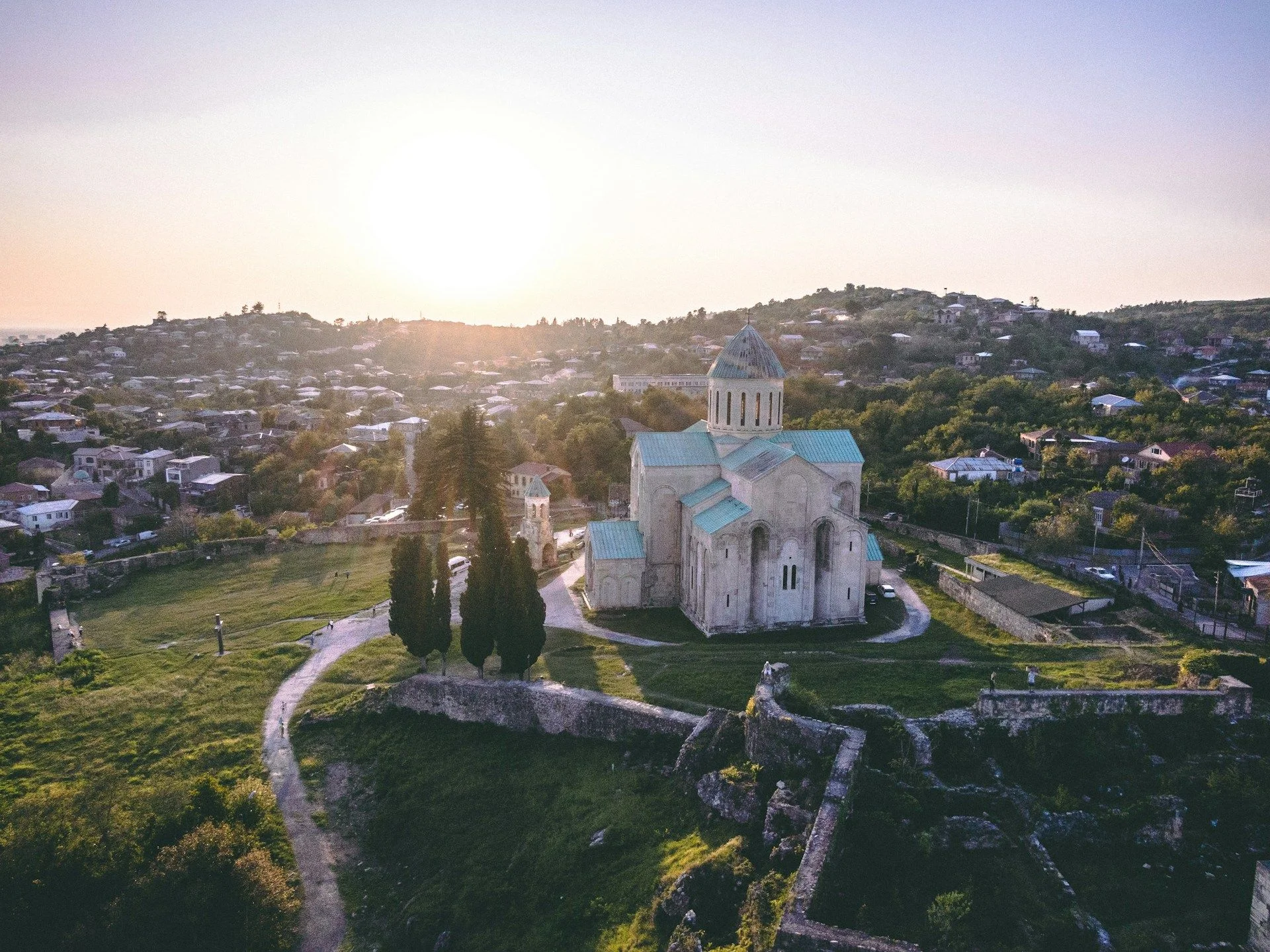Advantages of traveling
to Georgia
UNESCO sites and historic core
Kutaisi is home to the UNESCO-listed Bagrati Cathedral and Gelati Monastery. These medieval landmarks highlight Georgia’s spiritual legacy and attract visitors seeking meaningful cultural exploration.
Caves, canyons, and eco-adventures
Just outside Kutaisi lie Prometheus Cave and Okatse Canyon—top spots for hiking, boat rides, and eco-tourism. Nature lovers appreciate how close the city is to dramatic landscapes.
Quiet charm and easy access
Kutaisi offers a calm, local atmosphere with affordable prices and easy travel connections. It’s a preferred base for travelers exploring Western Georgia beyond the typical tourist trail.
UNESCO sites and historic core
Kutaisi is home to the UNESCO-listed Bagrati Cathedral and Gelati Monastery. These medieval landmarks highlight Georgia’s spiritual legacy and attract visitors seeking meaningful cultural exploration.
Caves, canyons, and eco-adventures
Just outside Kutaisi lie Prometheus Cave and Okatse Canyon—top spots for hiking, boat rides, and eco-tourism. Nature lovers appreciate how close the city is to dramatic landscapes.
Quiet charm and easy access
Kutaisi offers a calm, local atmosphere with affordable prices and easy travel connections. It’s a preferred base for travelers exploring Western Georgia beyond the typical tourist trail.

Useful articles
and recommendations from experts
Tourism in Kutaisi: A Complete Guide
Why Kutaisi is attractive for travelers
Kutaisi, one of the oldest cities in Georgia and the country’s third-largest, is increasingly becoming a favorite destination for travelers seeking a balance of cultural depth and natural beauty. Located in the Imereti region of western Georgia, Kutaisi offers rich historical landmarks, dramatic landscapes, and a slower pace of life compared to Tbilisi or Batumi. It is particularly appealing for cultural tourists, eco-tourism enthusiasts, and independent travelers exploring beyond mainstream routes.
As a former capital of Georgia and a hub of medieval learning and spirituality, Kutaisi holds deep cultural significance. The presence of two UNESCO World Heritage Sites—the Bagrati Cathedral and the Gelati Monastery—cements its status as a must-visit location for history and heritage. At the same time, its proximity to natural wonders like Prometheus Cave and Okatse Canyon offers striking outdoor adventures just a short drive away.
Key tourism offerings and travel styles
Kutaisi supports a diverse range of travel experiences. History lovers will find the city’s architectural legacy and religious sites particularly rewarding. The Gelati Monastery, founded in the 12th century by King David the Builder, is not only an architectural masterpiece but also a former center of learning where scholars studied theology, astronomy, and philosophy. The Bagrati Cathedral, although partly ruined, sits on a hilltop with panoramic views over the city and the Rioni River. Both sites offer insight into Georgia’s medieval era and Orthodox Christian traditions.
The city center itself is compact and walkable, featuring restored 19th-century buildings, lively local markets, cozy cafes, and public squares. The Colchis Fountain on central David Agmashenebeli Square is a focal point, with gilded replicas of ancient artifacts from the Colchian culture. Strolling through Kutaisi’s old quarters reveals quiet backstreets, vine-covered courtyards, and everyday Georgian life away from tourist crowds.
For those drawn to nature and adventure, Kutaisi is a gateway to some of Georgia’s most iconic natural attractions. The Prometheus Cave, located just 20 km from the city, is one of the largest cave systems in the country. Visitors explore its dramatic stalactites, stalagmites, and underground rivers on foot and by boat. Okatse Canyon and Martvili Canyon are also within reach, providing scenic hiking trails, suspension bridges, and turquoise waters ideal for boat rides and photography. These sites have become popular for day trips from Kutaisi, offering dramatic scenery with minimal travel time.
Eco-tourism and rural exploration are also growing in popularity. Travelers can visit traditional Imeretian villages, sample homemade wine and cuisine, and witness age-old agricultural practices. Local guesthouses in villages like Tskaltubo or Gelati provide warm hospitality and opportunities to experience Georgia’s rural life. Travelers interested in sustainability, organic food, and slow travel will find much to enjoy in the region surrounding Kutaisi.
Local logistics and visitor regulations
Kutaisi is one of Georgia’s most accessible cities thanks to the presence of Kutaisi International Airport (KUT), also known as David the Builder Airport. The airport serves low-cost carriers like Wizz Air and connects the city to numerous European destinations, including Warsaw, Vienna, Milan, Berlin, and Tel Aviv. Many travelers from Europe use Kutaisi as their first entry point into Georgia due to these convenient and affordable flight options.
Public transport in Kutaisi includes city buses and marshrutkas (minibuses). The city is compact, and most attractions in the center are reachable on foot. Taxis and ride-hailing apps such as Bolt are available and affordable. Car rental is also a popular option for visitors who want to explore the surrounding nature reserves, caves, and villages at their own pace.
Visa regulations for visiting Kutaisi are the same as for the rest of Georgia. Citizens of over 95 countries can enter Georgia visa-free for up to one year, making it one of the most open and traveler-friendly destinations in the region. The local currency is the Georgian lari (GEL), and credit cards are accepted in many places, though it’s advisable to carry cash for small businesses, taxis, and markets.
Accommodation options in Kutaisi range from budget hostels and family-run guesthouses to stylish boutique hotels and international chains. Many hotels are located around the city center, with views of the Rioni River or within walking distance of cultural landmarks. Prices are lower than in Tbilisi or Batumi, making Kutaisi an attractive option for budget-conscious travelers.
Seasonal demand and visitor flows
Tourism in Kutaisi peaks during spring and summer, particularly from May to September, when the weather is warm and nature is in full bloom. This is the best season for outdoor adventures like canyon hikes, cave exploration, and countryside excursions. Temperatures during this period range from 20°C to 30°C (68°F to 86°F), and most tourism infrastructure operates at full capacity.
Autumn (September to November) is another ideal time to visit Kutaisi. The region’s forests turn golden, vineyards begin the harvest season, and temperatures remain mild. Wine tours and rural stays become particularly popular in this season, offering a more tranquil and immersive travel experience.
Winter (December to February) is the low season, but it’s still worth considering for travelers interested in cultural tourism, budget travel, or long-term stays. While some attractions may be less accessible, many remain open, and the city offers a quiet, authentic atmosphere. Kutaisi’s moderate winter climate—with less snow than in eastern Georgia—makes it comfortable for sightseeing.
Overall, Kutaisi is less crowded than Georgia’s more famous cities but offers equal, if not greater, charm and access to diverse experiences. As more travelers seek destinations that are authentic, affordable, and rooted in history and nature, Kutaisi’s popularity continues to grow.
Why choose Kutaisi for your next trip
Kutaisi provides a unique mix of cultural depth, natural beauty, and local authenticity. It allows travelers to explore medieval cathedrals, walk through ancient cave systems, and relax in quiet town squares—all within close proximity. The city’s manageable size, slower rhythm, and lower prices make it an ideal destination for those who want to avoid crowds and connect more deeply with Georgian culture.
It’s also one of the best starting points for exploring western Georgia. Within a two-hour radius of Kutaisi are destinations like the spa town of Tskaltubo, the wine villages of Baghdati and Zestafoni, the mountainous Racha region, and the coastal city of Poti. This centrality allows travelers to use Kutaisi as a base for diverse regional excursions.
Additionally, Kutaisi is perfect for travelers who want to combine cultural and eco-tourism. One day you might explore an ancient monastery; the next, you’ll find yourself trekking across forested trails or descending into glowing limestone caves. It’s this variety—cultural richness and geographic diversity—that makes Kutaisi stand out.
How VelesClub Int. supports travel planning
VelesClub Int. helps travelers plan smooth and enriching journeys to Kutaisi. Through our platform, you can browse curated accommodations, book guided excursions to nearby canyons and monasteries, and discover hidden gems across the Imereti region. We connect you with local hosts, drivers, and tour operators who understand the needs of international travelers and offer personalized, trustworthy services.
For those considering a longer stay or investing in property, VelesClub Int. provides real estate support and legal assistance tailored to the Kutaisi region. Whether you're here to explore UNESCO sites, hike in nature, or simply unwind in a quiet Georgian town, we ensure your experience is seamless and fulfilling from arrival to departure.

